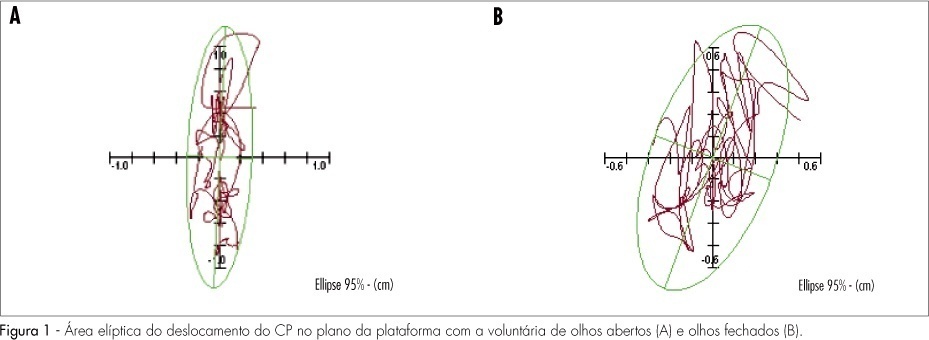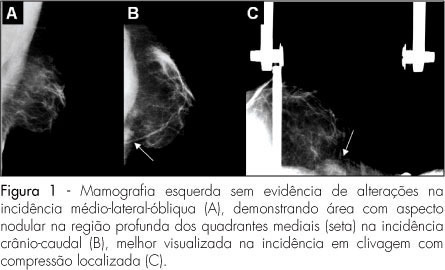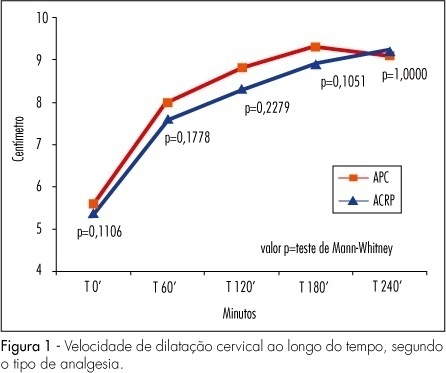Summary
Revista Brasileira de Ginecologia e Obstetrícia. 2009;31(10):508-512
DOI 10.1590/S0100-72032009001000007
PURPOSE: to check epidemiological data from a breast diagnostic clinic. METHODS: mammographies from 35,041 patients were studied, within a period of 2 years and 7 months, from 2004 to 2006, 32,049 (91.5%) of them from screening, and 2,992 from symptomatic patients (8.5%). The calculated parameters were: detection rate of the screening patients, percentage of cancer among the symptomatic patients, rate of biopsy indication, percentage of minimal, in situ, and stage 0-1 carcinomas, recall rate, and predictive value of mammographies considered as abnormal and of biopsies' indications in screening patients. RESULTS: 228 diagnoses of breast cancer were made, 111 in screening patients (0.34% detection rate) and 117 in symptomatic patients (3.91% detection rate). The number of biopsies' recommendations among screening patients was 544 (1.7% of those patients). There were 28% of minimal carcinomas, 10% of in situ carcinomas and 93% of stage 0-1 carcinomas among the screening patients. Recall rate was 19%. Positivity of mammographies considered as abnormal (VPP1) was 1.65%. The rate of biopsies' positivity (VPP2) was 21.9%. CONCLUSIONS: this study brings important epidemiological data for the audit of mammographic screening, rare among us. Data have been analyzed as compared to what is recommended by the literature, the detection rate and the percentage of minimal and in situ carcinomas found being comparable to the established values, but with the VPP value lower than the ideal.
Summary
Revista Brasileira de Ginecologia e Obstetrícia. 2009;31(10):503-507
DOI 10.1590/S0100-72032009001000006
PURPOSE: to evaluate the impact of hysterectomy on the sexuality of women with uterine leiomyoma. METHODS: prospective study including 33 sexually active women, with ages from 35 to 50 years old, with orgasmic experience and with a fit stable partner. All the women were submitted to two instruments for the evaluation or their sexuality: Sexual Quotient - Female Version (SQF) and Sexual Satisfaction Inventory - Female Version (SSIF). Both instruments were applied by the same examiner, before and six months after the hysterectomy. RESULTS: the SQF has shown that 39.4% of the patients presented deterioration in the sexual intercourse, even though there has not been found an association between the SQF results before and after hysterectomy (χ2= 0.6; degree of freedom=12; p=0.05). The mean scores obtained after the application of the SSIF have shown significant deterioration in the following parameters: sexual satisfaction (p=0.03); expression of feminine sensuality (p=0.01); vaginismus/dyspareunia (p=0.02) and anorgasmia (p=0.04). CONCLUSIONS: it seems that hysterectomy has a negative impact on women's sexual life, with reports of decreased libido, arousal and orgasmic capacity.
Summary
Revista Brasileira de Ginecologia e Obstetrícia. 2009;31(10):496-502
DOI 10.1590/S0100-72032009001000005
PURPOSE: to evaluate the rate of fall and its association with stabilometric parameters in postmenopause women, with or without osteoporosis. METHODS: transversal cohort study including 266 over 60-year-old women with and without osteoporosis, with at least 12 months of amenorrhea. The women were interviewed about the occurrence of falls in the previous 12 months, and about clinical and sociodemographic information. The osteoporosis diagnosis was done through bone densitometry and the postural stability evaluated through a stabilometric platform. For statistical analysis, mean, standard deviation, percentage, Mann-Whitney test, χ2 and Odds Ratio, and Spearman's correlation coefficient have been calculated. RESULTS: women with osteoporosis presented lower body mass index (BMI), lower schooling, shorter hormonal therapy and sooner menopause onset. The rate of fall was significantly higher in the group of women with osteoporosis (51.1%) (p<0.01), that presented an adjusted risk of 1.9 (1.3 to 3.4) times higher of falls and 3.2 (1.2 a 8.2) times higher of recurrent falls than the group without osteoporosis. Women with osteoporosis presented higher amplitude of Y axis oscillation in the open-eye test, than women without osteoporosis. The adjusted correlation analysis between stabilometric parameters and falls has not shown any significant correlation. CONCLUSIONS: women with post-menopausal osteoporosis present higher rate of falls and higher risk of recurrent falls, as compared with women without osteoporosis.

Summary
Revista Brasileira de Ginecologia e Obstetrícia. 2009;31(10):492-495
DOI 10.1590/S0100-72032009001000004
PURPOSE: to report a series of three cases of a normal variation known as sternal muscle, simulating a breast lesion. METHODS: the diagnostic suspicion was based on the clinical picture, findings in the physical examination and imaging, being confirmed by sectional imaging methods such as computerized tomography (CT) and magnetic resonance imaging (MRI). A review of the literature has been made in the data Medline and in breast radiology textbooks about the anatomic, clinical and imaging aspects of the sternal muscle. RESULTS: three female patients, without complaints, who presented nodular breast lesions in the medial quadrants projection (two in a routine mammographic exam and one in a computerized tomography). The diagnosis of sternal muscle was confirmed through breast MRI or through thoracic CT, showing an elongated image in the left parasternal region, adjacent to the breast muscle. CONCLUSIONS: the sternal muscle is an unusual variation of the muscles of the thoracic wall, present in about 2 to 8% of the population. The knowledge of this entity is crucial, as it can simulate a breast node.

Summary
Revista Brasileira de Ginecologia e Obstetrícia. 2009;31(10):485-491
DOI 10.1590/S0100-72032009001000003
PURPOSE: to compare maternal and perinatal results, after the use of continuous peridural versus combined rachidian and peridural analgesia in primiparous parturients. METHODS: randomized clinical trial with 128 primiparous pregnant women in labor, divided into two groups: peridural analgesia (CPA) with 65 women, and combined continuous rachidian and peridural analgesia (CRPA) with 63, all of them admitted in the pre-labor period at two maternities in Jundiai, in the state of São Paulo. The variables studied were: latency of analgesia onset, pain intensity, total time until complete dilation, Apgar index at the first and fifth minutes, labor duration, degree of motor blockade, adverse effects such as vomiting, pruritus, arterial hypotension and degree of maternal fulfillment. Inclusion criteria were: primiparous, physical condition ASA 1 and 2, an only foetus, cephalic presentation, term delivery, 3 to 6 cm cervical dilation, and analgesia required by the obstetritian. Women with morbidity, membrane rupture, fetal abnormality and use of opioids up to four hours before were excluded. The Mann-Whitney test was used for the statistical analysis of non-parametric continuous variables, and Fisher's exact and Pearson's χ2 tests, for the categoric variables. RESULTS: there was no difference between the groups concerning the length of cervical dilation, labor duration, maternal hemodynamic parameters, newborn vitality, analgesic complementation during labor and type of delivery. Analgesia onset was quicker in the CRPA group, and the CPA group presented less motor blockade. Differences concerning adverse effects such as nausea, vomiting, pruritus and hypotension have not been observed, but hypotension was more frequent in the CPA group (6.3 versus 3.1%). CONCLUSIONS: both techniques have proved to be safe and efficient, but CRP has provided an earlier onset, with quicker pain relief. The lesser motor blockade in the CPA group has allowed the parturients more active movements in bed and more effective collaboration during the expulsion period. Most women were pleased with the analgesia they got. The doses of local anesthetics and opioids used in both analgesic techniques and the complementary doses, equal in both groups, neither had any significant adverse effect nor affected newborn vitality.

Summary
Revista Brasileira de Ginecologia e Obstetrícia. 2009;31(10):480-484
DOI 10.1590/S0100-72032009001000002
PURPOSE: to evaluate epidemiological aspects in recurrent adolescence pregnancy. METHODS: cohort study including 187 pregnant adolescents attended and followed-up for five years after delivery in an adolescent's attendance service in Ceará state. Age group, being or not at school, living with parents, schooling, marital status and the present partner's condition were analyzed. Data were processed by the EPI-INFO program. Statistical analysis of the independent variables (age, schooling, being at school, having a job, living with parents, marital status and switching partners) was done and compared to the dependent variable (being or not pregnant after five years). The Fisher's exact test was used to evaluate the association among factors which could influence the pregnancy recurrence, the association being present when p<0.05. Risks related to schooling, marital status and multiple partners have been calculated, since these were significant factors for pregnancy recurrence. RESULTS: 61% of the adolescents got pregnant in the five years after the first delivery. Factors such as age, school, work or living with parents were not protective. Nevertheless, when the adolescents had eight or less years of schooling, the risk of getting pregnant has almost duplicated (relative risk (RR)=1.8 (CI95%=1.3-2.6)). New pregnancies were more frequent among the single adolescents without a stable partner (RR=1.3 (CI95%=1.1-1.6) and among the ones who had multiple partners (RR=1.4 (CI95%=1.1-1.7)). CONCLUSIONS: low schooling, multiple partners and non-stable bonds were risk factors for pregnancy recurrence.
Summary
Revista Brasileira de Ginecologia e Obstetrícia. 2009;31(9):447-452
DOI 10.1590/S0100-72032009000900005
PURPOSE: to compare the effects of functional electrostimulation of the pelvic floor and therapy with cones in women with stress urinary incontinence (SUI). METHODS: randomized clinical study for which 45 patients with SUI were selected. The effects of functional electrostimulation of the pelvic floor were evaluated in the SUI treatment of 24 women, with the use of clinical data (micturition diary, pad test and a questionnaire about quality of life - I-QoL). The patients were submitted to two 20' weekly sessions for four consecutive months, under the supervision of a physiotherapist. The electrode used had 10 cm length and 3.5 cm width with a double metallic ring and a cylindrical shape, positioned in the medium third of the vagina. The electric parameters used were: intensity varying from 10 to 100 mA and 50 Hz of fixed frequency, with pulse duration of 1 ms. Also, we evaluated 21 patients who were submitted to vaginal cone treatment. The cone therapy was done with two 45 minute sessions per week. The cones' weight varied from 20 to 100 gr. RESULTS: there was no difference between the outcomes of electrostimulation of the pelvic floor and the vaginal cones for the treatment of SUI (p>0.05). After four months, there was a significant improvement in the I-QoL index of the patients treated both with electrostimulation (40.3 versus 82.9) or with the cones (47.7 versus 84.1). There was a significant decrease in pad weight in both groups, measured before and after the treatment (28.5 and 32 g versus 2.0 and 3.0 g for the electrostimulation and cone group, respectively). Finally, there was a significant decrease in the number of urinary leakage evaluated by the micturition diary in both groups (p<0.0001). CONCLUSIONS: both electrostimulation and vaginal cones were effective in the treatment of women with SUI.
Summary
Revista Brasileira de Ginecologia e Obstetrícia. 2009;31(9):427-432
DOI 10.1590/S0100-72032009000900002
PURPOSE: to evaluate the repercussion of portal hypertension in the indexes of the ovarian, uterine and luteus body periphery arterial resistance, at the medium luteal phase of the menstrual cycle. METHODS: in an observational study with transversal cohort, 28 patients with hepatosplenic schistosomiasis mansoni, submitted to splenectomy and ligation of the left gastric vein (HESO), a similar group of 28 patients who had not had the surgery (HESNO) and 29 healthy volunteers (HV) were submitted to Doppler fluxmetry in the medium luteal phase of the menstrual cycle. Pourcelot's resistance index has been used as RI=[(S-D)/S], in which S means the highest systolic speed, and D, the end of diastole. The best record in the ascendant branch of the uterine artery, in the ovarian artery, when accessible, or in the intraovarian artery, was chosen. When the luteus body was present, the RI was measured in its periphery. The data obtained were analyzed by Kruskal-Wallis and Mann-Whitney tests. RESULTS: there was no significant difference among the groups, concerning the mean RI of the ovarian arteries (Kruskal-Wallis, p=0.50). There was a tendency for higher right uterine artery RI in the HESNO group (Kruskal-Wallis, p<0.07), but it was similar in the left uterine artery (Kruskal-Wallis, p=0.14). Arterial RIs significantly lower have been observed in the luteus body periphery, when compared to the contralateral ovarian arteries in all the groups (Mann-Whitney, p<0.0001). CONCLUSIONS: there was no difference among the groups, regarding the ovarian and uterine RIs. The portal hypertension in patients with hepatosplenic schistosomiasis does not affect the natural phenomenon of arterial RI decrease in the ovary where ovulation occurs.